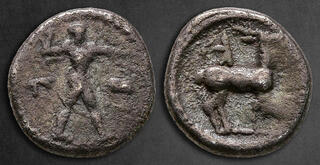| Savoca Numismatik GmbH & Co. KG > Online Auction 209 | Silver | Auction date: 28 April 2024 |
| Lot number: 20 Price realized: 60 EUR (Approx. 64 USD) Note: Prices do not include buyer's fees. | Show similar lots on CoinArchives Find similar lots in upcoming auctions on |
| Lot description: Bruttium. Kaulonia circa 475-425 BC. 1/6 Nomos AR 10 mm, 1,29 g Apollo advancing right, holding branch; to right, stag standing right, head reverted / Stag standing right; laurel branch before. Nearly Very Fine Noe, Caulonia, -; SNG ANS - ; HN Italy -. cf. CNG EA 224 lot 17. In Greek mythology, Apollo, the god of prophecy, music, healing, and the sun, was often depicted alongside a stag, which was considered one of his sacred animals. The stag symbolized grace, swiftness, and the untamed beauty of the wilderness, qualities that were closely associated with Apollo's domain. The imagery of Apollo and a stag is rich with symbolism and mythology. Apollo was often depicted as a handsome and youthful god, often holding a lyre, a laurel branch, or a bow and arrows. The stag, on the other hand, was revered for its nobility and agility, often depicted with majestic antlers and a regal bearing. One of the most famous myths involving Apollo and a stag is the story of the Ceryneian Hind, a golden-horned deer sacred to Artemis, Apollo's twin sister. During one of his adventures, Apollo pursued the hind across the wilderness, showcasing his skill as an archer and hunter. The hind was eventually caught by Heracles (Hercules) as part of his Twelve Labors. In art and literature, the imagery of Apollo and a stag often symbolizes the harmonious relationship between the divine and the natural world. It conveys themes of beauty, grace, and the interconnectedness of all living beings. The stag's presence alongside Apollo serves as a reminder of the god's connection to the wilderness and his role as a protector of the wild creatures. On ancient coins, the depiction of Apollo and a stag would have reinforced these mythological associations, while also serving as symbols of divine favor, prosperity, and civic pride for the city or region that minted the coins. The imagery would have resonated with worshippers of Apollo and those who revered the natural world, highlighting the enduring influence of mythology on ancient coinage and culture. Starting price: 50 EUR |  |


